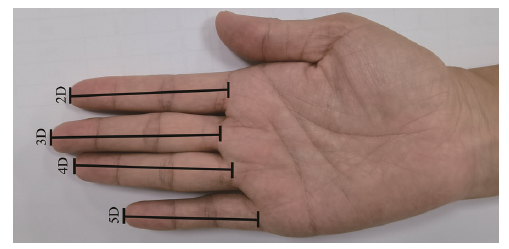

Relationship between finger length ratio and psychological status of Han Chinese college students in Zhejiang Province
Received date: 2023-08-29
Revised date: 2024-01-15
Online published: 2024-08-13
This study investigates the relationship between the digit ratio (specifically, the ratio of the second to the fourth finger, R2/4) and mental health status among Chinese Han ethnicity college students in Zhejiang. Mental health, defined as the state of well-being in which every individual realizes their own potential, can cope with the normal stresses of life, can work productively and fruitfully, and is able to make a contribution to their community, is of paramount concern in the educational context of Chinese universities. This research involved 473 Chinese Han ethnicity college students aged 19 to 22 from Zhejiang province (161 males and 312 females), with an average age of 20.24±0.651 years. The mental health of the participants was assessed using the Chinese version of the Symptom Checklist-90 (SCL-90), and digit ratios were calculated by measuring the linear distance from the midpoint of the proximal crease to the tip of the second to fifth fingers on both hands using an electronic digital caliper. The findings revealed that the average scores for the nine factors of the SCL-90 ranged between 1.409 and 1.973, with females scoring higher than males in all factors except for somatization and hostility, where no significant gender differences were observed. Apart from the R2/3 and R3/4 ratios of both hands and the R2/4 ratio of the left hand (P>0.05), all other digit ratios were significantly higher in females than in males. Among males, the R3/4 ratio of the left hand was positively correlated with obsessive-compulsive symptoms, whereas the R4/5 ratio was negatively correlated. The R2/3 and R2/4 ratios of the right hand were negatively correlated with interpersonal sensitivity, paranoia, and anxiety, respectively. The R2/5 ratio was negatively correlated with both interpersonal sensitivity and anxiety. In females, the R2/4 ratio of the right hand was negatively correlated with interpersonal sensitivity, phobia, and paranoia. The R3/4 ratio was negatively associated with phobia, while the R4/5 ratio showed a positive correlation. No significant correlations were found between other digit ratios and the SCL-90 factors. The preliminary results suggest a potential link between digit ratios and mental health status, influenced by a complex interplay of biological, environmental, and experiential factors. Future research should employ diverse methodologies to further validate the relationship between digit ratios and mental health and explore the underlying biological mechanisms. This study not only offers a new perspective for mental health research but also contributes to understanding the biological basis of human behavior and personality.

Key words: Digit ratio; Mental health; SCL-90; Han population
TANG Tingbing , YE Xiancai , ZHANG Jun , CHEN Guangping , FAN Xiaowen , YE Xiaoou . Relationship between finger length ratio and psychological status of Han Chinese college students in Zhejiang Province[J]. Acta Anthropologica Sinica, 2024 , 43(04) : 668 -674 . DOI: 10.16359/j.1000-3193/AAS.2024.0042
| [1] | 张海音. 医学心理学[M]. 上海: 上海交通大学出版社, 2015, 54-55 |
| [2] | 傅小兰, 张侃, 陈雪峰, 等. 心理健康蓝皮书:中国国民心理健康发展报告(2017-2018)[M]. 北京: 社会科学文献出版社, 2019, 14-15 |
| [3] | 理查德-格里格, 菲利普-津巴多. 心理学与生活[M].译者:王垒,王甦. 北京: 人民邮电出版社, 2016,422-459 |
| [4] | Sundblad C, Eriksson E. Reduced extracellular levels of serotonin in the amygdala of androgenized female rats[J]. European Neuropsychopharmacology, 1997, 253-259 |
| [5] | Sang WJ, Ho-Kyoung Y, Changsu H, et al. Second-to-fourth digit length ratio as a measure of harm avoidance[J]. Personality and Individual Differences, 2016, 97: 30-34 |
| [6] | Sheng Y, Qian W, Wang L, et al. Decreased digit ratio (2D:4D) and gastric cancer in Chinese men[J]. Early Human Development, 2016, 103: 109-112 |
| [7] | Hull MJ, Schranz NK, Manning JT, et al. Relationships between digit ratio (2D:4D) and female competitive rowing performance[J]. American Journal of Human Biology, 2015, 27(2): 157-163 |
| [8] | Austin EJ, Manning JT, Mcinroy K, et al. A preliminary investigation of the associations between personality, cognitive ability and digit ratio[J]. Pers Individ Dif, 2002, 33(7): 1115-1124 |
| [9] | Ronalds G, Phillips DIW, Godfrey KM, et al. The ratio of second to fourth digit lengths: a marker of impaired fetal growth?[J]. Early Human Development, 2002, 68(1): 21-26 |
| [10] | Bailey AA, Hurd PL. Depression in men is associated with more feminine finger length ratios[J]. Pers Individ Dif, 2005, 39(4): 829-836 |
| [11] | Vermeersch H T. Sjoen G, Kaufman JM, et al. 2d: 4d, Sex steroid hormones and human psychological sex differences[J]. Hormones and Behavior, 2008, 54(2): 340-346 |
| [12] | 周玉来, 宋国林, 朱守兰, 等. 武警某机动部队战士指长比与心理健康水平关系的研究[J]. 中国民康医学, 2014, 26(6): 2 |
| [13] | 余春艳, 左霞云, 廉启国, 等. 上海市青春早期青少年指长比与性发育抑郁及攻击行为关联[J]. 中国学校卫生, 2017, 38(2): 4 |
| [14] | 陆宏, 王璐, 李可可, 等. 示指和环指指长比与医学生人格的关系[J]. 解剖学杂志, 2018, 41(6): 707-710 |
| [15] | Lautenbacher LM, Neyse L. Depression, neuroticism and 2D:4D ratio: evidence from a large, representative sample[J]. Scientific Reports, 2020, 10(1): 11136 |
| [16] | Shabnam A, Zahra Z. Association of digit ratio with depressionand hopelessness in females[J]. Int J Basic Sci Med, 2021, 6(3): 100-104 |
| [17] | 虞琴, 李相龙, 王晨曦, 等. 指长比与地方院校医学生心理健康状态的关系[J]. 解剖学杂志, 2022, 45(4): 360-363 |
| [18] | 汪向东, 王希林, 马弘. 心理卫生评定量表手册(增订版)[M]. 北京: 中国心理卫生杂志社, 1999, 31-35 |
| [19] | 席焕久. 人体测量方法[M]. 北京: 科学出版社, 2010, 87-127 |
| [20] | 刘媛媛, 武圣君, 李永奇, 等. 基于SCL-90的中国人群心理症状现况调查[J]. 中国心理卫生杂志, 2018, 32(5): 437-441 |
| [21] | 陆宏, 霍正浩, 帅志云, 等. 宁夏回族和汉族群体指长比的研究[J]. 解剖学报, 2008, 39(2): 267-271 |
| [22] | 陈桐君, 相健美, 滕少康, 等. 福建闽南地区汉族与畲族的指长比[J]. 人类学学报, 2022, 41(1): 6 |
| [23] | Manning JT. Resolving the role of prenatal sex steroids in the development of digit ratio[J]. Proc Natl Acad Sci USA, 2011, 108(39): 16143-16144 |
/
| 〈 |
|
〉 |